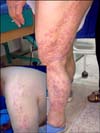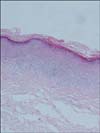Abstract
A 50-year-old man and 71-year-old woman presented to our clinic with unilateral, linear, erythematous, pruritic lesions along the lines of Blaschko. On the basis of clinical and histopathological findings, the lesions were diagnosed as lichen planus with a Blaschkoian distribution, which is a rare form of lichen planus. The patients were treated with topical corticosteroids and antihistamines.
Lichen planus is a dermatosis that may involve skin, mucous membranes, and nails. Many morphological variants have been described. However, cases of linear lichen planus following the lines of Blaschko are rare in the literature1,2,3,4,5,6,7. Here, we report 2 cases of lichen planus with unilateral lesions following the lines of Blaschko.
A 50-year-old man presented with a history of linear pruritic lesions on his right arm that had appeared 2 months earlier. Physical examination showed violaceous polygonal papules following the lines of Blaschko on the right arm (Fig. 1). The mucous membranes, scalp, and nails were unaffected. His personal history was not significant, and he had no history of drug intake. Hepatitis B and C serology was negative. Histopathological examination revealed lichenoid band-like lymphohistiocytic infiltrate at the dermoepidermal junction, dyskeratotic keratinocytes, wedge-shaped hypergranulosis, and orthokeratosis consistent with lichen planus (Fig. 2). The patient was treated with topical corticosteroids and antihistamines. However, he did not return for follow-up.
A 71-year-old woman presented with a history of pruritic lesions over the left half of the body that appeared 2 months earlier. Physical examination showed violaceous polygonal papules following the lines of Blaschko on the left side of the body including the left leg and arm (Fig. 3). The patient had been using olanzapine for 2 years because of schizophrenia. The mucous membranes and nails were normal. Histopathological examination revealed orthokeratosis, wedge-shaped hypergranulosis, lichenoid band-like lymphohistiocytic infiltrate at the dermoepidermal junction, eosinophil infiltration, and dyskeratotic keratinocytes (Fig. 4, 5). She did not discontinue olanzapine and was treated with topical corticosteroids and antihistamines. One month after treatment initiation, her lesions healed with post-inflammatory pigmentation.
The present patients had lichen planus along the lines of Blaschko, which were described by Blaschko in 1901. The lines of Blaschko do not correspond to any known nervous, vascular, or lymphatic structures but represent the developmental growth pattern of the skin. They follow a V-shape over the upper spine, an S-shape on the abdomen, and an inverted U-shape from the breast area onto the upper arm. There are also perpendicular lines down the front and back of the lower extremities. They were previously thought to represent Koebner's phenomenon, but the curvature of the lesions does not support this hypothesis8. The lines of Blaschko are probably determined by cell migration during embryogenesis; the lines represent boundaries between populations of normal skin and mutant cells9. Several congenital and acquired skin disorders follow the lines of Blaschko10. Although lichen planus following the lines of Blaschko is very rare, Kabbash et al.2 reviewed cases that were previously reported to be linear lichen planus and propose they actually follow the lines of Blaschko and that a Blaschkoian distribution is underrecognized. Furthermore, they propose Blashkoian lichen planus is a manifestation of a loss of heterozygosity in skin with a predisposition to the disease.
The trigger leading to the development of Blaskoian lichen planus in patient 2 might have been the use of olanzapine. Despite the eosinophil infiltration in the histopathology, it is unknown if the lichenoid eruption was due to olanzapine, because olanzapine treatment was not stopped and the lesions healed with topical corticosteroid therapy. Fernández-Torres et al.11 report the case of a patient who developed lichenoid drug eruption due to olanzapine. In their patient, the eruption developed 4 months after olanzapine therapy compared to approximately 2 years later in the present patient. In addition, 2 cases of lichenoid eruption following the lines of Blaschko due to ibuprofen and nicergoline have been reported12,13.
The differential diagnosis of lichen planus following the lines of Blaschko includes lichen striatus, linear psoriasis, inflamatuar linear verrucous epidermal nevus, blaschkitis, and linear Darier-White disease2,10. Clinical and histopathological examination can help differentiate between these disorders.
Topical and oral corticosteroids as well as oral antihistamines are mostly used in the treatment of lichen planus following the lines of Blaschko with good response; however, persistent pigmentation might remain2.
These cases are important, because although lichen planus is common, the variant following the lines of Blaschko is uncommon and should be kept in mind in the differential diagnosis of lesions following the lines of Blaschko.
Figures and Tables
 | Fig. 2Orthokeratosis, wedge-shaped hypergranulosis, lichenoid band-like lymphohistiocytic infiltrate at the dermoepidermal junction, and dyskeratotic keratinocytes (H&E, ×100). |
References
1. Sharma R, Maheshwari V, Chandra M. Unilateral multiple linear lichen planus along the lines of blaschko: A report of two cases. Indian J Dermatol Venereol Leprol. 1999; 65:225–226.
2. Kabbash C, Laude TA, Weinberg JM, Silverberg NB. Lichen planus in the lines of Blaschko. Pediatr Dermatol. 2002; 19:541–545.

3. Long CC, Finlay AY. Multiple linear lichen planus in the lines of Blaschko. Br J Dermatol. 1996; 135:275–276.

4. Ber Rahman S, Ul Bari A, Mumtaz N. Unilateral Blaschkoid lichen planus involving the entire half of the body, a unique presentation. Dermatol Online J. 2007; 13:36.
5. Numata Y, Okuyama R, Tagami H, Aiba S. Linear lichen planus distributed in the lines of Blaschko developing during intramuscular triamcinolone acetonide therapy for alopecia areata multiplex. J Eur Acad Dermatol Venereol. 2008; 22:1370–1372.

6. Mérigou D, Léauté-Labrèze C, Louvet S, Bioulac-Sage P, Taïeb A. Lichen planus in children: role of the campaign for hepatitis B vaccination. Ann Dermatol Venereol. 1998; 125:399–403.
7. Nanda A, Al-Ajmi HS, Al-Sabah H, Al-Hasawi F, Alsaleh QA. Childhood lichen planus: a report of 23 cases. Pediatr Dermatol. 2001; 18:1–4.

8. Tagra S, Talwar AK, Walia RS. Lines of Blaschko. Indian J Dermatol Venereol Leprol. 2005; 71:57–59.

9. Moss C. Mosaicism and linear lesions. In : Bolognia JL, Jorizzo JL, Schaffer JV, editors. Dermatology. 3rd ed. China: Elsevier Limited;2012. p. 943–962.
11. Fernández-Torres R, Almagro M, del Pozo J, Robles O, Martínez-González C, Mazaira M, et al. Lichenoid drug eruption induced by olanzapine. Actas Dermosifiliogr. 2008; 99:221–224.





 PDF
PDF ePub
ePub Citation
Citation Print
Print






 XML Download
XML Download